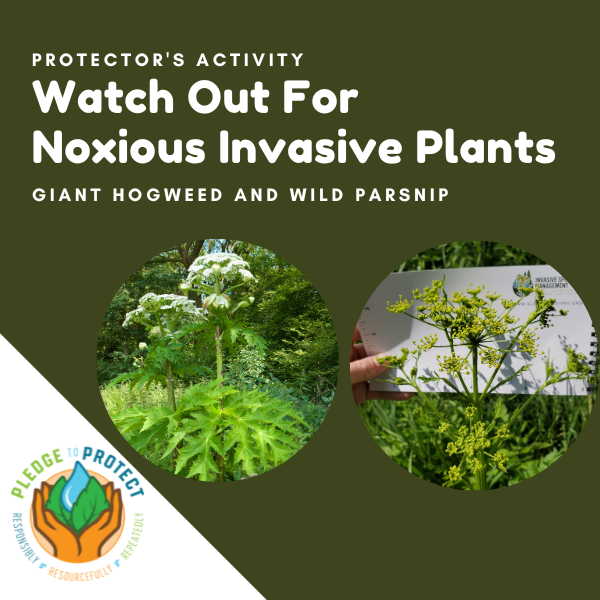What's The Issue?
Giant hogweed (Heracleum mantegazzianum) and wild parsnip (Pastinaca sativa) are two invasive plants that are also considered to be noxious as contact with their sap will cause severe skin irritation.
While you’re enjoying the outdoors in your own backyard or on your favorite trail or waterway, keep an eye out for these noxious invasive plants that could really hinder your outdoor experience!
Identification, Reporting and Control Options:

Overview:
Giant hogweed begins to emerge in early spring. Their leaves differ depending on the life stage; emerging cotyledons have more rounded leaves that emerge from three thin stems, as the plant matures the leaves become deeply ridged and a compound in arrangement eventually forming a rosette after multiple growing seasons; mature giant hogweed plants can grow between 10-15 feet tall with leaves up to 5 feet wide, flowers are white and umbel shaped, and stems have purple blotches and white course hairs.
Giant hogweed has two major impacts, ecological and human health. It suppresses the growth of native plants, which has a negative impact on the animals that depend on them. In addition, direct skin contact with giant hogweed induces extreme photosensitivity, which can lead to severe, slow-to-heal burns and scarring. Costs are incurred for both medical treatment and efforts to keep the plant under control. Over 100,000 seeds per plant are dispersed annually by water, wind, or humans.
Steps to Follow if You Find Giant Hogweed:
- Do Not Touch The Plant! The sap will cause severe burns and irritation if it comes into contact with your skin.
- Take pictures of the entire plant, as well as the stem, leaves, flower, and/or seed.
- Note the location and number of plants.
- Email ghogweed@dec.ny.gov or call the NYS DEC Giant Hogweed Information Line at 845-256-3111
- NYS DEC offers free site visits and management guidance for confirmed giant hogweed sites.
Control Options for Giant Hogweed
The sap inside the stem of giant hogweed can cause severe burns if it comes into contact with skin. For safety, follow these steps from the NYS DEC website to remove giant hogweed.

Overview:
Wild Parsnip, (Pastinaca sativa), is a biennial perennial herb native to Eurasia.
During the first one to two years, wild parsnip plants will be in the form of a low-lying rosette. Eventually, a hollow grooved flower stalk will rise about 2-5 feet high growing yellow umbel-shaped flowers in the late summer. Leaves resemble the leaves of celery and have two to five sharply-toothed paired leaflets that grow along the stem. Stems are yellowish-green in color with vertical grooves (no red/purple blotches or hairs) and can grow up to 5 ft. tall. Flowers resemble Queen Anne’s lace but are a greenish-yellow color. The flat-topped cluster (umbel) can grow 2-6 inches in diameter. Wild parsnip blooms from late June through July. Seeds mature by early July. Plants die after producing seeds. Seeds can remain viable in the soil for up to four years.
Steps to Follow if You Find Wild Parsnip:
- Avoid walking through areas where wild parsnip is present. Do not let your skin come into contact with broken stems of wild parsnip as the sap can cause severe skin irratation.
- If your skin comes into contact with the sap of wild parship, wash the affected area thoroughly with soap and water, and keep it covered and avoid exposure to the sun for at least 48 hours to prevent a reaction. See a physician if a reaction occurs.
Control Options:
Virtual Toolboxes
Visit the Protector’s Virtual Toolboxes below to access resources themed for each category, and to learn more about how to protect your favorite outdoor spaces from invasive species.
Lands & Trails
Lands & Trails
Forests
Waters
Gardens
Communities
Did you enjoy this blog post? Take our Pledge to Protect and get monthly emails showcasing actions you can take to protect your favorite hiking trails, paddleways, forests, garden, and community from the impacts of invasive species!
Take the Pledge to Protect
The Pledge-to-Protect is a fun, positive, inviting, engaging and rewarding way to participate in invasive species prevention and management.
|
|



